Final report for ONE22-429
Project Information
In the Northeast, lice are the most problematic pest for cattle producers in the winter months. During winter housing, lice are transmitted easily between animals and populations can explode resulting in significant animal welfare and production losses. This study developed and tested an essential oil based formulation for winter cattle lice, for organic producers and those wishing to reduce reliance on chemical treatments. Essential oils were chosen based on known insecticidal efficacy in combination with favorable mammalian safety data, and tested against lice at different concentrations in laboratory assays. The formulation was then tested in on-farm field trials with the herd of 60 Belted Galloway cattle at Philo Ridge Farm, VT.
Lice were collected from cattle by passing the animals through an Arrowquip chute and removing them from aggregation sites (head, neck, withers, back, rump). Our laboratory trials showed that at a concentration of 4% essential oils, the formulation resulted in 97% louse mortality after 15 mins exposure. Increasing the concentration to 8% resulted in 100% louse mortality after 15 mins exposure. A control containing just the mineral oil base resulted in 40% lice mortality, and there was 0% mortality in another control containing no oils at all. For the on-farm field trials, cattle were passed through the chute to count lice numbers, and the formulation was applied by pouring it along the backline and brushing it in. For adult cattle 1000 mL was applied, 500 mL for yearlings and 250 mL for calves. Louse counts were repeated after two weeks, and a second treatment administered. This occurred at the beginning of the winter (November) to examine whether the formulation could prevent lice building up, and again in January when lice populations were high to assess efficacy in treating already established lice infestations. The project was a success and we found that our essential oil formulation of lavender, clove, and thyme in a mineral oil base was highly effective at both preventing and treating winter lice infestations in cattle, resulting in a 97 - 100% reduction in lice numbers after treatment.
Farmers then used the formulation in cattle self groomer-scratchers to reduce time and labor costs associated with individual treatment. This was effective in suppressing lice numbers however was not as good as the individual treatment via pour-on essential oils, for example calves could not reach it. This enabled us to conclude that effective management can be achieved through a combination of the cattle groomer-scratcher supplemented by individual pour-on of the essential oils for specific animals if needed.
This work has resulted in reduced chemical inputs for the farmers, who are continuing to use the essential oils for winter lice and no longer need to purchase insecticide. Farmers noted that applying the essential oil formulation was not much more effort than applying pour-on insecticide which they previously would have to use every year, so the labor involved was favorable. A neighboring farm also adopted the essential oil formulation for use in a groomer-scratcher in their barn in winter, allowing them to reduce insecticide use. After our on-farm workshop event 100% of farmer participants reported their knowledge about lice management increased, 94% indicated their knowledge about alternative/organic management increased, and 89% of participants indicated they would implement the strategies we discussed. Out of these people 78% indicated they are considering using the essential oil formulation. We will continue to promote this practice as an alternative winter lice treatment option for organic producers or those wishing to reduce chemical inputs. The results of this project would benefit any cattle producers in a climate such as the Northeast where animals must be housed in the winter and are therefore at risk of losses due to heavy lice infestations.
This project will develop and test essential oil-based formulations for the control of winter cattle lice.
Objective 1: Identify essential oils of known insecticidal activity against lice, and carrier oils already approved for organic cattle production. Essential oils will be evaluated for suitability with partner farmers, show high louse mortality at low concentrations, and be safe to apply to cattle based on previous literature and safety data.
Objective 2: Test the efficacy of combinations of essential oils and carrier oils against lice in the laboratory using contact and vapor bioassays. The final formulation developed for the field trial (objective 3) will show ≥90% louse mortality at a concentration of ≤10%.
Objective 3: Test the efficacy of the formulation against lice in an on-farm field-trial and using the self-groomer/scratcher oil-dispenser. Cattle will be housed in two groups to compare the impact of the essential oil formulation against the carrier oil control.
Impact: The results will demonstrate the efficacy of a new tool for farmers to control cattle lice using a time and labor-saving application technique, for use across diverse management systems. Reduced economic, environmental, animal health burden of winter cattle lice in the Northeast and increased confidence for farmers
Lice infestations during winter housing represent a significant challenge for cattle producers in the Northeast, particularly for organic producers wishing to raise cattle without using chemical inputs. Lice are the most important winter parasites of cattle, spreading easily between animals during housing, causing intense irritation and scratching which can impact welfare, reduce feed intake, and damage hides, resulting in production losses for farmers (Currin, 2008). The USDA estimated that US livestock producers lose $125 million a year to cattle lice (Campbell, 1992). Cattle in the Northeast can be infested with biting lice (Bovicolla bovis) which feed on skin debris and secretions, and sucking lice (Linognathus vituli; Solenopotes capillarus; Haematopinus eurysternus) which pierce the skin and suck blood from small vessels near the surface (White et al., 2007). The lifecycles are similar and take 3-4 weeks from egg to adult during cold weather, with 1-2 eggs laid per day, resulting in severe infestations if not managed correctly (Campbell, 1992).
Clinical disease is usually prevented though the routine application of chemical insecticides. Injectable formulations are only effective against sucking lice which ingest blood, so topical (pour-on) formulations are required to treat biting lice. None are effective against lice eggs so must be reapplied after 2-3 weeks to kill newly hatched lice (Currin, 2008). For organic producers, treatment options are extremely limited: diatomaceous earth, soap, and plant (e.g. canola) and mineral oils may be used, and Neem and Pyrethrin must be approved before use (Pedretti, 2014). Furthermore, there are growing concerns over the development of resistance to conventional insecticides (Levot, 2000; Sands et al., 2014; Mckiernan et al., 2021), as well as the off-target environmental impacts of veterinary parasiticides on beneficial insects due to residues in manure and water (Sands and Wall, 2018; Mooney et al., 2021; Sands and Noll, 2021). After treatment of livestock, a large proportion (often >90%) of the dose is excreted unmetabolized in the urine and/or manure, representing a significant source of environmental contamination (Mooney et al., 2021).
This project has been co-developed with Vermont organic cattle farmers in response to their expressed need for alternative control strategies during winter housing, when lice populations regularly reach unacceptable levels resulting in animal health and production concerns (personal communication, Sands and partner farmers). In a 2022 survey of Vermont cattle producers (n=55), 84% reported external parasites as an important issue on their farm and 73% wanted to find alternative methods of control (Sands, unpublished data). Other farmer surveys surrounding pest and parasite control methods further highlight this need, with cattle lice ranked second (after internal parasites) as the most important problem for beef cattle producers (Ferguson et al., 2006) and 80% of producers regularly treating for lice. In a survey of organic dairy producers in the Northeast, Integrated Pest Management (IPM) was unequivocally the highest priority animal health challenge, identified by 89% of respondents (Pereira et al., 2013).
Botanical insecticides are naturally occurring insect toxins which degrade rapidly in the environment and generally have low mammalian toxicity. For example, essential oils are volatile plant secondary metabolites, consisting of up to 80 compounds such as terpenes and aromatic hydrocarbons. Many of these have cellular or neuronal targets which elicit an insecticidal effect, deterring insect herbivory on the plant. The value of essential oils as control agents against veterinary ectoparasites, particularly lice, mites, and ticks, are well documented (Ellse and wall, 2013). Laboratory tests showed that 5% tea tree and lavender oils resulted in >80% mortality of donkey lice Bovicola ocellatus after 2 hours of exposure (Ellse et al., 2013). When formulated with emulsifiers (SLS and PVP) efficacy increased to 100% mortality after 2 hours (Sands et al., 2015) and, unlike many chemical insecticides, they were highly ovicidal meaning lice eggs were also killed. Field trials were conducted with formulations of 5% tea tree or lavender oil as a solution that was groomed into the coats of winter-housed donkeys (Ellse et al., 2015). After 2 applications there was a 78% reduction in louse abundance, suggesting that essential oils can be used to manage louse populations successfully in the field.
Plant based ethno-veterinary medicine is used in the sustainable management of livestock ectoparasites worldwide (Tesfaye et al., 2015; Gemechu et al., 2019) but represents a form of traditional knowledge that has been under-represented in Northeast agriculture. The volatile nature and short half-life of essential oils are desirable for low environmental toxicity but means they must be applied regularly and penetrate the coat to reach lice next to the skin. This is less problematic for companion animals such as donkeys which are groomed regularly but has been an obstacle for their use in livestock management. As a result, large scale field trials with livestock, building on the promising results from laboratory investigations, have been limited (Ellse and Wall, 2013). To address these challenges, this project will develop essential oil formulations with high insecticidal activity against cattle lice in the laboratory, and then investigate their efficacy in a field trial with winter-housed cattle using a novel application technique - a cattle self-groomer/scratcher oil-dispenser. Essential oils will be formulated with carrier oils already approved in organic production, at the lowest concentration that can achieve ≥90% lice mortality in the laboratory.
The self-groomer/scratcher has a tank which wicks oil-based solution into the brushes as cattle rub against them, facilitating coat penetration and offering a time and labor-saving route of administration for farmers. This research will develop and test an environmentally sustainable alternative for winter cattle lice control, which could be widely adopted by diverse farming communities in the Northeast, providing additional tools, particularly within organic and traditional systems, for producers wishing to avoid chemical treatments. The project will contribute towards the Northeast SARE’s outcome statement by diversifying management options for cattle producers to reduce the economic, environmental, and animal health burden of winter lice infestations. This will increase resiliency, sustainability, and quality of life by providing additional tools to farmers amid rising concerns over the impacts of resistance and climate change on pest and parasite transmission.
Cooperators
- - Producer
- - Producer
- - Technical Advisor
Research
Methods as proposed (see results for laboratory and on farm field trial descriptions)
Objective 1 [year 1]: A literature search of peer-reviewed research will be conducted (Web of Science, Google Scholar) to identify essential oils of high insecticidal activity against lice. To be considered for testing in this study, essential oils must result in high louse mortality (≥90%) at low concentrations (≤10%) so that formulations can be developed that are cost effective and safe to apply to livestock. Further requirements will be the absence of mammalian toxicity, and essential oils will be shortlisted following a review of safety data sheets and toxicological information. The insecticidal activity and safety data, along with physical samples of the essential oils, will be discussed and evaluated with the partner farmers so that they can identify the most suitable to be tested in the laboratory (objective 2). Preferred carrier oils from those already approved in organic production will be selected for use in the essential oil formulations. Finally, safety, efficacy, and formulation of chosen oil combinations will be discussed in consultation with ectoparasite control expert Richard Wall via video teleconferencing.
Objective 2 [year 1]: To test the efficacy of essential oils against lice in the laboratory, they will be formulated with the carrier oils at concentrations of 8% and 4% and used in contact filter paper bioassays. Lice will be collected from naturally infested winter-housed Belted Galloway beef cattle with partner farmers at Philo Ridge Farm, Vermont (supporting materials 1). Cattle will be passed through an Arrowquip chute and examined for lice at aggregation sites on the body (face, head, neck, withers, brisket, inner legs, and base of the tail). Lice will be removed using a small, hard bristled brush, collected in specimen tubes, and returned to the laboratory. Four species of cattle lice are found in the Northeast, one biting and three sucking (Rutz and Waldron, 2016), and the species present will be identified using a dissecting microscope and morphological keys (Price and Graham, 1997). If both biting and sucking lice are found, bioassays will be performed separately on each group to test efficacy. Lice will be maintained in an incubator at 20 °C and 75% RH in darkness prior to use, and bioassays will be conducted the day following collection.
Alongside the formulations of carrier and essential oils, the carrier oil alone will be used as a control. A 1-mL aliquot of each formulation will be applied to a 90-mm-diameter filter paper resting in a 90-mm polystyrene Petri dish to fully saturate the filter paper. Ten adult lice will be placed onto each filter paper, ensuring that lice cannot avoid contact. Lids will be placed on the Petri dishes, and maintained at 30 °C and 75% RH in a constant temperature incubator. Louse survival will be recorded at 15-min, 1 h, and 24 h. For this the Petri dish will be removed from the incubator and the lice inspected for movement; lice will be considered dead if they are immobile and fail to show any movement even after agitation with a pin. Three replicates of each essential oil formulation concentration, and each carrier oil only control, will be performed.
The resulting mortality data will consist of three replicates of 10 lice for each essential oil formulation concentration and the carrier oil only control. For statistical analysis, louse mortality will be used as the dependent variable in a three-way analysis of variance (ANOVA) with essential oil type, concentration, and carrier oil as factors. Tukey multiple range tests will be used for post hoc analysis. Data will be summarized, presented graphically, and in a farmer-friendly information sheet which will be distributed during outreach workshops and field days.
Objective 3 [year 2]: The results from objective 2 will be used to take forward a final essential oil formulation to be tested in field trials and using a cattle self-groomer/scratcher dispenser (supporting materials 3). The essential oil – carrier oil combination with the highest efficacy at the lowest concentration to achieve ≥90% mortality in the laboratory will be chosen in consultation with partner farmers. On-farm trials will take place with partner farmers at Philo Ridge Farm, Vermont, where all animals have a history of persistent lice infestation during housing. Cattle will be housed in two groups, one barn with 30-60 steers and the other with 30-60 cows plus yearlings. Prior to setting up the self-groomer/scratcher oil-dispensers, lice on the cattle will be counted by passing them through the Arrowquip chute. Ten body sites on each animal will be examined: around the eye, neck, withers, inner leg, and base of the tail on either side. Hair will be parted five times in 5 cm lengths and the total number of lice at each site will be recorded using a click counter. To administer the essential oil formulations, it will be poured along the backline of the cattle while they are being passed through the chute at a rate of 1 L per adult cow, 500 mL for a yearling, and 250 mL for a calf. The trial will commence in November before lice have built up to assess preventative efficacy, and again at the time of highest louse abundance in January to assess treatment efficacy. In November, one barn will receive the essential oil formulation, and the other will be an untreated control (supporting materials 4). This will be switched in January so that the barn not receiving treatment in November will receive it in January and vice versa. All animals will be passed through the chute again after 2 weeks and louse numbers will be re-counted as described above. A second treatment will be applied and then 2 weeks later all animals will be passed through the self-groomer/scratcher again for a final lice count to be made. The following year the formulation will be administered to cattle in the self-groomer scratcher instead of directly poured on their back.
Data on the efficacy of the essential oil formulations in the field will therefore consist of lice numbers infesting cattle before, during and after application of the treatment (essential oil formulation) and control (no treatment). A percent louse reduction for each group will be calculated. For statistical analysis, the number of lice on each animal will be the response variable in a repeated measures ANOVA comparing the average louse abundance at each inspection between treatment groups. Data will be summarized, presented graphically, and in a farmer-friendly information sheet which will be distributed during outreach workshops and field days.
Laboratory trial
We developed a formulation based on lavender, clove, and thyme oils with a mineral oil base. Essential oils of lavender (40/42 standardized), clove bud, and white thyme (Bulk Apothecary, Ohio, USA) were mixed into the mineral oil base at concentrations of 5%, 2.5%, and 0.25%, respectively to achieve a total concentration of 7.75% essential oils. We also tested this at half-strength (total concentration 3.875%). Lice were collected from naturally infested winter-housed Belted Galloway beef cattle with partner farmers at Philo Ridge Farm, Vermont by passing cattle through an Arrowquip chute and removing lice using forceps and a small, hard bristled brush. Lice were returned to the laboratory and maintained at a standard humidity and temperature until use in mortality assays (the same day).
Alongside the two concentrations of the formulations of essential oils in a mineral oil base, two controls were implemented: mineral oil only, and a dry filter paper (no treatment). A 1-mL aliquot of each formulation was applied to a 90-mm-diameter filter paper resting in a 90-mm polystyrene Petri dish to fully saturate the filter paper. Ten adult lice were placed onto each filter paper and louse survival was recorded at 15-min, 1 h, and 24 h. Lice were considered dead if they were immobile and failed to show any movement even after agitation with a pin. Three replicates of each essential oil formulation concentration and each control were performed.
The 7.75% formulation resulted in 100% louse mortality after 15 mins exposure. At half the concentration (3.875%) there was 97% louse mortality after 15 mins exposure. The control containing just mineral oil resulted in 40% lice mortality, and there was 0% mortality in the other control containing no oils (untreated) (Fig. 1). At 24 hours, mortality was generally higher for all treatment groups because lice did not survive well for extended periods in the laboratory 0ff-host. These differences were statistically significant. Lice mortality for both concentrations of essential oil formulation was significantly higher than mortality in the mineral oil control (lower concentration Z32=2.1, P=0.036; higher concentration Z32=2.2, P=0.030). Compared to the untreated control, lice mortality was significantly higher for both essential oil formulations (lower concentration Z32=5.9, P<0.001; higher concentration Z32=6.0, P<0.001) and the mineral oil control (Z32=4.2, P<0.001).
On-farm field trial
We applied the formulation to a herd of approximately 60 certified organic Belted Galloway beef cattle with known problematic seasonal winter lice infestation. Animals were housed in 2 separate barns grouped as cows with their calves, and steers with some young heifers. Barns were situated 350 ft apart and some animals (such as the herd bull) were moved between the groups during the season. We used one group as the treatment group and the other group as the untreated control, and reversed these groups later in the season to account for confounding factors between barns. We counted lice before and after treatments. Twenty cattle from each barn were randomly selected by their ID number, and lice were counted by passing them through an Arrowquip chute system (Manitoba, Canada). Each animal was examined at 8 body sites including the neck, shoulder, back, and rump, on each side. The hair was parted in 50 mm sections and the skin observed for the presence of lice. Five partings were made at each body site giving a total of 40 counts per animal.
Lice counts were performed approximately every 2 weeks over the winter, depending on inclement weather. In November 2022, before lice numbers had increased, the cow-calf barn was given two applications of the essential oil formulation two weeks apart, with louse counts performed the morning before the application, and the steer barn was left untreated. In January 2023, when high lice populations were established, the steer barn was given two applications of the essential oil formulation two weeks apart, and the cow-calf barn was left untreated. For adults, yearlings, and calves, a volume of 1000 mL, 500 mL, and 250 mL respectively was applied as a pour-on along the back topline, and brushed into the coat. Two cattle in the untreated steer barn were removed from the study in December 2022 because they had very heavy lice infestations and received a moxidectin treatment.
Cattle had mixed infestations of chewing lice and sucking lice. Lice numbers started off low or absent at the beginning of winter and then increased sharply. They remained high for the rest of the trial period (until 9th March 2023). Lice were seen in all of the observed body parts (neck, shoulder, back, and rump) however there were significantly fewer lice on the rump than the shoulder (Z720=3.621, P<0.001) and back (Z720=3.227, p<0.01). Adult cows had the fewest lice, followed by, steers and steer calves, and heifer calves were the most heavily infested with significantly more lice than steer calves (Z108=-2.260, P<0.05) and adult cows (Z108=-6.078, P>0.001).
At the beginning of winter in November 2022, lice numbers in the untreated steer group significantly increased from an average of 0.7 lice per animal on day 14 to an average of 32 lice per animal on day 21 (Z38=7.562, P<0.001; Fig. 2). For the treated cow-calf group, lice numbers did not increase and were ≤1 per animal for the duration of the trial period. This indicates that the essential oil formulation was highly effective in preventing the build up of lice populations at the beginning of the winter.
Later in the winter in January 2023 when lice populations were high, lice numbers in the untreated cow-calf group did not significantly change over the trial and average lice numbers remained around 30±2 per animal. For the treated steer group, lice numbers significantly decreased from an average of 15 lice per animal to zero lice per animal after a single treatment and remained at zero for the rest of the trial (F1=22.9, P<0.001; Fig. 2). This indicates that the essential oil formulation was highly effective in treating an already high infestation of cattle lice.
Farm changes
This work has resulted in reduced chemical inputs for the farmers, who are continuing to use the essential oils for winter lice and no longer need to purchase insecticide. Farmers noted that applying the essential oil formulation was not much more effort than applying the Cydectin which they would have to use every year anyway, so the labor involved was favorable. A neighboring farm has also purchased a self-groomer scratcher and learnt how to make the essential oil formulation, which they now use in their barns for winter cattle lice and has allowed them to reduce the use of pyrethrin insecticide. After our on-farm workshop event 89% of participants indicated they would implement the strategies we discussed and out of these people 78% indicated they would consider using the essential oil formulation.

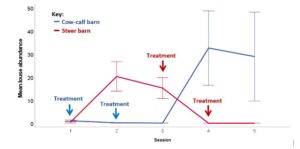
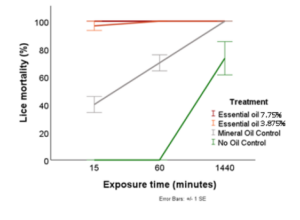
We developed a formulation based on lavender, clove, and thyme essential oils in a mineral oil base. The formulation was tested in the laboratory at various concentrations so that the lowest effective concentration could be found. Our laboratory trials showed that at a concentration of 4% essential oils, the formulation resulted in 97% louse mortality after 15 mins exposure. Increasing the concentration to 8% resulted in 100% louse mortality after 15 mins exposure. A control containing just mineral oil resulted in 40% lice mortality, and there was 0% mortality in another control containing no oils at all. We trialed the formulation with a herd of Belted Galloway cattle (Philo Ridge Farm, VT) by passing them through a chute, applying it along the back line, and brushing it in to their coat. There were two groups of animals housed in separate barns, the cow-calf group and the steer group. We applied the formulation to the cow-calf group at the beginning of winter, with the steer group as an untreated control. The essential oils prevented lice infestation in the cow-calf group (<1 louse per animal), whereas lice in steer group significantly increased to an average of 32 lice per animal. Later in winter, the formulation was applied to the steer group and lice numbers significantly decreased from an average of 15 per animal to zero. Meanwhile, lice numbers in the cow-calf group (who were not treated again) increased to an average of 30 lice per animal. These results indicate that the essential oil formulation effectively prevents as well as treats lice infestations in winter housed cattle.
To reduce time and labor costs, the essential oil formulation was used in cattle self groomer-scratchers that were set up on two separate farms. Cattle were able to self-administer the treatment on demand. This helped to prevent lice populations building up, however it was not as effective as administering the formulation directly to cattle by pouring along the backline. Effective management could be achieved through a combination of the cattle groomer-scratcher supplemented by individual treatment if needed, especially for calves which were more susceptible to lice and may not be able to reach the groomer-scratcher. This work has resulted in reduced chemical inputs for the farmers, who are continuing to use the essential oils for winter lice and no longer need to purchase insecticide.
Education & outreach activities and participation summary
Participation summary:
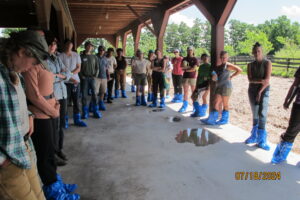

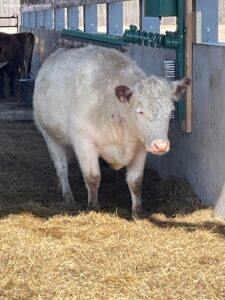
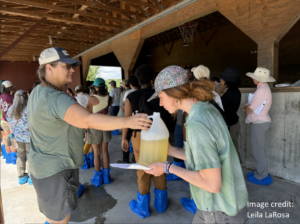
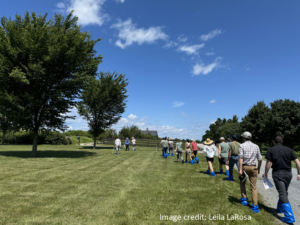
The project results have been shared through the UVM Extension Organic Dairy Conference held each year in VT. The 2023 Organic Dairy Conference was held in Randolph VT and attracted 111 organic dairy producers and stakeholders. The conference was attended by Jeffrey Sanders and Bryony Sands who reported on the project. The work was also discussed with participants at the UVM Extension NWCS field day in Alburgh VT in July 2023 which attracted 181 participants, and July 2024 which attracted 176 participants, including farmers, educators and service providers.
In July 2024 an intensive workshop and farm tour was held at the Philo Ridge Farm to provide education to stakeholders on livestock pest and parasite management. At the workshop we discussed the project outcomes, demonstrated how to prepare and administer the essential oil treatment, and discussed organic and alternative pest and parasite management strategies. The workshop was attended by 32 people including farmers, educators, and service providers. This educated farmers and service providers on the considerations associated with lice management strategies in the Northeast and introduced the benefits of essential oil formulations and the cattle self-groomer/scratcher. Farmers hosted the field day and participated in a farmer panel and project team members presented data collected from laboratory studies (year 1) and on-farm field trials (year 2).
Information gained through the project was used to develop a factsheet series which are posted at www.uvm.edu/extension/nwcrops (also available under Information Products):
- Factsheet 1 – 'Winter cattle lice Part 1: biology and life cycle of cattle lice' – provides information on the biology and lifecycle of winter cattle lice and the economic, environmental, and animal health importance of effective lice control.
- Factsheet 2 – 'Winter cattle lice Part 2: control of lice in cattle' – provides a summary of the various treatment and IPM options for controlling cattle lice in conventional and organic production systems.
- Factsheet 3 - 'Winter cattle lice Part 3: essential oils for the alternative control of cattle lice' – uses the results of the laboratory and on-farm field trials to provide information on the efficacy and benefits of using essential oils and the cattle self-groomer/scratcher.
Learning Outcomes
Identifying lice on cattle - when lice are present versus other skin conditions. When lice become active, which months they start to increase in the fall/winter. Examining cattle for lice, body areas they are found on, which types of lice are present (sucking or biting). Efficacy of essential oil treatments on lice - why they work, how long they might last, when they need reapplying based on the lice lifecycle. How to apply essential oil treatments, and time, labor, and financial costs and benefits compared to cydectin and pyrethrin treatments. Farmers also reported they learned about essential oils as a less environmentally harmful treatment option.
Project Outcomes
This work has resulted in reduced chemical inputs for the farmers, who are continuing to use the essential oils for winter lice and no longer need to purchase insecticide. Farmers noted that applying the essential oil formulation was not much more effort than applying the Cydectin which they would have to use every year anyway, so the labor involved was favorable. A neighboring farm has also purchased a self-groomer scratcher and learnt how to make the essential oil formulation, which they now use in their barns for winter cattle lice and has allowed them to reduce the use of pyrethrin insecticide.
After our on-farm workshop event 100% of farmer participants reported their knowledge about lice management increased, 94% indicated their knowledge about alternative/organic management increased, and 89% of participants indicated they would implement the strategies we discussed. Out of these people 78% indicated they are considering using the essential oil formulation.
Quotes:
- "Learned about less harmful treatment options"
- "I appreciate the accessibility and knowledge sharing"
- "Great program! Thank you!"
- "Excellent learning opportunity"
- "Very innovative methods"
- "Fantastic information"
This study aimed to develop and test an essential oil based formulation for winter cattle lice. We aimed to test essential oils against lice in the laboratory and develop a formulation for on-farm field trials with the herd of 60 Belted Galloway cattle at Philo Ridge Farm, VT. The project was a success and we found that our essential oil formulation of lavender, clove, and thyme in a mineral oil base was highly effective (97 - 100% reduction in lice) at both preventing and treating winter lice infestations in cattle. The reason for the success of this project was in a large part due to following the insights from the cooperating farmers on what would be most useful and valuable. For example, instead of just testing the formulation straight in the groomer-scratcher, we decided to apply it first by pouring it along the backline and rubbing it in whilst passing cattle through the chute. This enabled us to collect robust data on all animals groups, including calves who could not reach the groomer-scratcher, and showed that the formulation was very effective. It also enabled us to conclude that effective management could be achieved through a combination of the cattle groomer-scratcher supplemented by individual pour-on of the essential oils for specific animals if needed.
Challenges were presented by the winter weather delaying some aspects of the on-farm trial because we did not want to wet the cows with oil when it was too far below 0ºF! The availability of lice and lice eggs for laboratory studies was also a challenge because it took a long time to collect lice from cattle. This meant that we did not test the formulation against lice eggs in the laboratory, only adult lice. However, previously published research by project member Sands showed that essential oils do kill the eggs of the donkey louse (Bovicola ocellatus) so this was not integral to the project success. Finally, due to the initial large field trial being run with an adjusted method (pour-on essential oils instead of groomer-scratcher), time constraints of the project meant we were not able to collect robust data on the groomer-scratcher as a route of administration. This was implemented by the farm in second year of the project, and also by a neighboring farm, who reported that lice were indeed suppressed by the formulation being available in the groomer-scratcher and that they did not need to treat the animals with insecticide. However, additional future work might focus on a controlled field trial using the groomer-scratcher method.
Both farms plan to continue to use the essential oils in the groomer-scratcher and as a pour-on treatment because it is highly effective and much more favorable to them than using insecticide treatments. They report that it is financially cheaper than using conventional treatments (although still quite costly), and the time and labor commitment is similar. They have also tried it out against lice in their sheep herd after shearing although more research would be needed to develop an application method that would penetrate sheep fleece in the winter. We will continue to promote this practice as an alternative winter lice treatment option for organic producers or those wishing to reduce chemical inputs. The results of this project would benefit any cattle producers in a climate such as the Northeast where animals must be housed in the winter and are therefore at risk of losses due to heavy lice infestations.